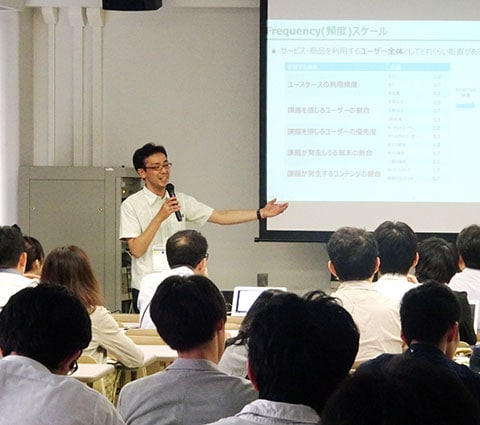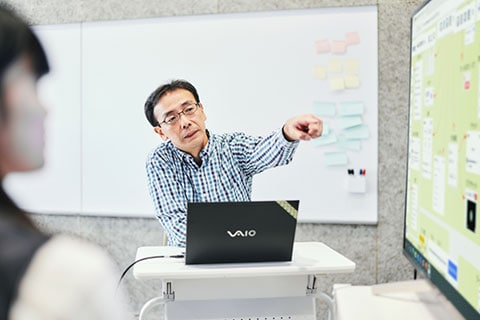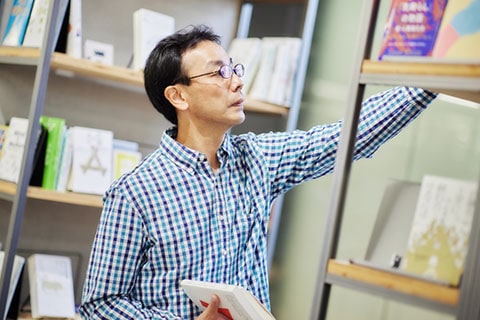PEOPLE


Constantly Pursuing Richer Experiences to Truly Delight Our Customers
Hiroto Watanabe
Sony Group Corporation Business Incubation Platform Business Operation Dept.
Graduate School of Information Systems
Standing in between technology and users to improve the value of experience
As a Human-Centered Design (HCD) expert, I am currently a member of the aibo development team engaged in a wide range of activities as part of our mission to enhance engagement between aibo entertainment robots and their owners. More specifically, I am in charge of conducting questionnaire and interview surveys of aibo owners with a view to identifying their essential needs, defining requirements and considering specifications for new software and services, and conducting post-release usage surveys.
When developing new software and services, our first priority is to incorporate essential needs into functionality while matching them to the worldview associated with the aibo. For example, the aibo Territory function tells aibo where you do not want it to go. It was developed in response to owners who want aibo to avoid going near places with dirty floors such as kitchens and bathrooms. Instead of using the map on the app screen to define administrative areas that aibo should not enter, users place chili peppers, which dogs dislike, on the map, thus enriching their lives with aibo by telling it not to approach certain areas.
 Photo caption: The aibo Territory function notifies your aibo of places you want it to avoid by placing chili peppers, which dogs dislike
Photo caption: The aibo Territory function notifies your aibo of places you want it to avoid by placing chili peppers, which dogs dislikeOur aim is to create experiences that go beyond ease of use and make you eager to use our products
I first became aware of HCD around 2007-2009 when I was in charge of UI design for portable navigation systems. At the time, I felt that easy-to-use UIs alone fell short and was looking for solutions. Around the time when smartphones were beginning to appear on the market, I saw magazines using the expression "UX" for enabling users to do what they want more comfortably, and I learned from textbooks that HCD helps improve UX still further. In the process, I began to understand that creating the desire to use something is an important element of UX and resolved to understand more about it.
In order to study UX from basic principles, I enrolled in a graduate school educational program for working professionals called "Human-Centered Design" and systematically studied everything from cognitive science to information architecture, concept design methods, and usability evaluation. As I simultaneously continued to practice HCD at actual development genba, my high level of expertise and achievements were recognized and I acquired certification as an in-house HCD expert. I utilize the strengths I have cultivated throughout my career in my daily efforts to achieve better experiences. These include the ability to approach things from the perspective of both developers and users, and the ability to see the entire HCD process from the genba.
- *UI: User Interface, UX: User Experience

Visualizing the invisible quality of usability
One of the most memorable moments in my work to date was when I worked on a smartphone/tablet application development team and we clarified the definition of hitherto vague usability quality standards as "Usability Damage Level Guidelines." Of course, Sony developers place great importance on ease of use, but at the time, their thinking and priorities varied from person to person, and in some cases, fixing usability issues was put on the back burner. In order to improve the situation, we believed that guidelines were needed to set common standard for prioritizing such issues.
Using ISO definitions as reference, we compiled guidelines that classified UI problems found during application development into four damage levels based on a Severity Scale measuring the extent to which the problem makes users reluctant to use the application, and a Frequency Scale measuring the extent to which the problem impacts users' overall use of services and products. In this way, we established a mechanism for taking appropriate countermeasures based on common standards. Moreover, these guidelines themselves were created by putting HCD into practice with a focus on usability while considering who would use the apps and why. Introducing this process into the app development team made all members more aware of usability from the initial development stage, improving overall app UX. The guidelines have been adopted by other projects within the company, and we have also had opportunities to present them at external expert meetings, where they have been well-received.

Getting closer to diverse users, and listening to all opinions
With regard to HCD, my motto is to get closer to each individual user and listen to all opinions. I attend fan meetings as an aibo counselor and find it an invaluable experience to interact directly with owners. However, not all of them are willing to share their opinions proactively through such venues and social networking fan groups. For this reason, I carefully analyze logs and other data related to aibo to ensure that I do not miss any opinions that are not expressed at fan meetings or in surveys.
It is important not to simply accept the owners' opinions collected in this way, but to examine them and extract the essential needs hidden within them. I then continue to thoroughly discuss and consider together with team members how to please customers more and what kind of experiences Sony should provide.

Popularizing the HCD concept within the company and contributing to improving experience values
As a future goal, we would like to ensure the HCD concept spreads throughout the Sony Group's operating companies. HCD is a fundamental guideline for product development and is more effective when understood not only by developers, but also by all members of the product planning, design, and marketing departments. I also feel that co-creating with such team members under the guiding principles of HCD should ultimately enable us to create experiential values that satisfy the essential demands of users. It is vital to ensure users are truly happy with our products and services, not simply release them and leave it at that. For this reason, I believe I can still contribute much to the Sony Group through my HCD leadership activities.


